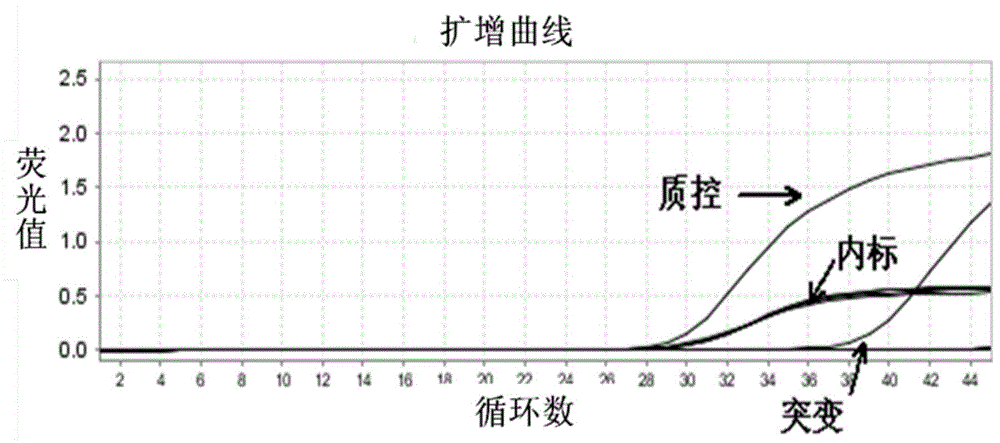Reagent kit used for testing PIK3CA (phosphatidylinositol-4,5-bisphosphate3-kinase, catalytic subunit alpha) gene mutations
A kit and reagent technology, applied in biotechnology and medical fields, can solve the problem of low sensitivity, achieve high sensitivity, simple and effective detection method, and excellent performance
- Summary
- Abstract
- Description
- Claims
- Application Information
AI Technical Summary
Problems solved by technology
Method used
Image
Examples
Embodiment 1
[0107] Prepare a PIK3CA gene mutation detection kit, specifically comprising the following steps:
[0108] 1. Synthetic primers and probe sequences
[0109] Synthetic primer sequences SEQ ID NO:1, SEQ ID NO:2, SEQ ID NO:4, SEQ ID NO:5, SEQ ID NO:7, SEQ ID NO:8, SEQ ID NO:10-SEQ ID NO:13 ; Synthetic specific probe sequences SEQ ID NO:3, SEQ ID NO:9 and SEQ ID NO:14, wherein SEQ ID NO:3 and SEQ ID NO:9 label the FAM fluorescent group at the 5' end, and the 3' end Label the quenching group NFQ-MGB modification group, SEQ ID NO: 14 is labeled with the VIC fluorescent group at the 5' end, and the quenching group TAMRA is labeled at the 3' end.
[0110]The above primer sequences were respectively prepared into 100 μM mother solution for storage, and the above probe sequences were respectively prepared into 100 μM mother solution for storage.
[0111] 2. Synthetic Blocking Nucleic Acid Sequence
[0112] Synthetic MGB blocking nucleic acid sequence SEQ ID NO:6, and carry out MGB-NF...
Embodiment 2
[0120] Use the PIK3CA gene mutation detection kit prepared in Example 1 to detect the samples to be tested.
[0121] In this embodiment, 50 cases of paraffin-embedded tissue sections of colorectal cancer patients diagnosed by clinicopathology were collected, and genomic DNA was extracted therefrom, and the PIK3CA gene mutation detection kit obtained in Example 1 was used to detect whether there was PIK3CA gene in the samples to be tested E542K, E545K, E545D, H1047R, and H1047L mutations are verified by traditional sequencing methods. The specific steps are as follows:
[0122] 1. Extraction of Genomic DNA from Samples
[0123] Genomic DNA was extracted from the tissue samples of the above lung cancer patients using a DNA extraction kit (QIAamp DNA FFPE Tissue Kit, Cat No. 56404). The DNA extraction method was carried out according to the instruction manual, and the operation steps were briefly described as follows: Place the clinically collected paraffin-embedded tissue (≤25m...
Embodiment 3
[0140] Prepare a PIK3CA gene mutation detection kit, specifically comprising the following steps:
[0141] 1. synthetic primer and probe sequence (with embodiment 1)
[0142] 2. synthetic blocking nucleic acid sequence (same as embodiment 1)
[0143] 3. Preparation of fluorescent quantitative PCR reaction system
[0144] Prepare the mutation detection reaction system containing No. 1-5 reagent, the quality control detection reaction system containing No. 6 reagent, the No. 7 reagent containing enzyme mixture, weak positive control and blank control, and the components are as follows in Table 3 Shown:
[0145] Components of No. 1-9 reagents in Table 3
[0146]
[0147]
[0148] The above PCR buffer contains dNTPs, magnesium ions and other necessary components for PCR reaction.
PUM
 Login to View More
Login to View More Abstract
Description
Claims
Application Information
 Login to View More
Login to View More - R&D
- Intellectual Property
- Life Sciences
- Materials
- Tech Scout
- Unparalleled Data Quality
- Higher Quality Content
- 60% Fewer Hallucinations
Browse by: Latest US Patents, China's latest patents, Technical Efficacy Thesaurus, Application Domain, Technology Topic, Popular Technical Reports.
© 2025 PatSnap. All rights reserved.Legal|Privacy policy|Modern Slavery Act Transparency Statement|Sitemap|About US| Contact US: help@patsnap.com



